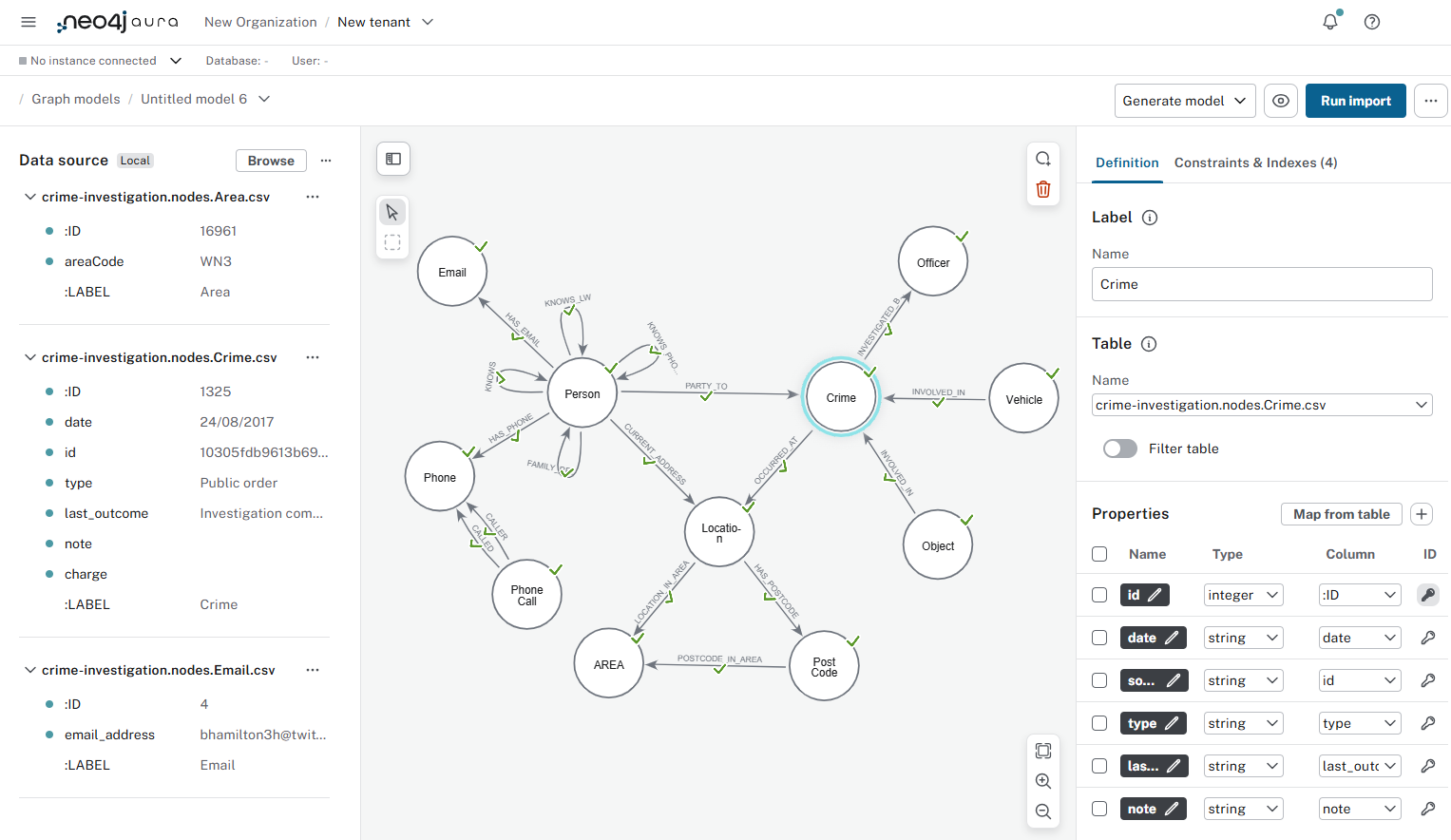In this lesson, you will explore some tools you can use to import data into Neo4j.
You will learn about:
-
Data Importer
-
Cypher and LOAD CSV
-
neo4j-admin
-
ETL tools
-
Custom application
Data Importer
The Neo4j Data Importer is a "no-code" tool that facilitates data importing from relational data sources into Neo4j. Its graphical user interface allows for simple data conversion into nodes and relationships.

Data Importer allows you to:
-
Visually define the graph data model, including nodes, relationships, and properties.
-
Upload CSV files and link to relational databases
-
Map fields to properties
-
Define unique ID constraints and indexes
If your Neo4j database is hosted on Aura DB you can import data directly from several cloud hosted relational databases, including:
-
PostgreSQL
-
MySQL
-
SQL Server
-
Oracle
-
Snowflake
Data Importer is an excellent tool for quickly importing data into Neo4j without writing any code.
Cypher and LOAD CSV
Cypher has built-in support for importing data from CSV files using the LOAD CSV clause.
LOAD CSV WITH HEADERS FROM 'file:///transactions.csv' AS row
MERGE (t:Transactions {id: row.id})
SET
t.reference = row.reference,
t.amount = toInteger(row.amount),
t.timestamp = datetime(row.timestamp)You can control the import process by writing Cypher queries to:
-
Load data from CSV files
-
Create the data model
-
Transform and aggregate data
-
Control transactions
You can learn more about using Cypher and LOAD CSV in the Importing CSV data into Neo4j
GraphAcademy course.
neo4j-admin
The neo4j-admin import command line interface supports importing large data sets. neo4j-admin import converts CSV files into the internal binary format of Neo4j and can import millions of rows within minutes.
The neo4j-admin import command expects you to format the data in a specific way and requires the database to be offline during the import process.
Data should preferably be clean and transformed before importing, as faults in the data will reduce the performance of the import process.
The neo4j-admin import is a highly configurable high-performance tool, applicable when you need to import large data sets very quickly.
You can learn more about using neo4j-admin import in the Neo4j-admin import tutorial.
ETL (Extract, Transform, Load) Tool
An ETL tool, for example Apache Hop, is a good choice for importing data from multiple sources. ETL tools generally support various data sources, can transform data into the desired format, and have visualization tools.
Many organizations use ETL tools to import data into Neo4j because they can handle complex data transformations and integrations.
Custom integration using Neo4j drivers
Building a custom application to load data into the graph database is a good option if you have complex business rules or need to integrate with other systems. A custom application will allow you complete control over the import process and integration with other systems and data sources.
There are several GraphAcademy courses for developers, where you can learn how to build applications using Neo4j drivers.
Mixed approaches
In practice, you may use a combination of these tools to import data into Neo4j. For example, you may use Data Importer for quick prototyping, Cypher for small data sets, and ETL tools for complex data transformations.
You may also choose to do one-off batch imports using one tool and real-time data ingestion using another tool.
Summary
In this lesson, you learned about various tools to import data into Neo4j.
In the next module, you will learn how to import CSV data using Data Importer.